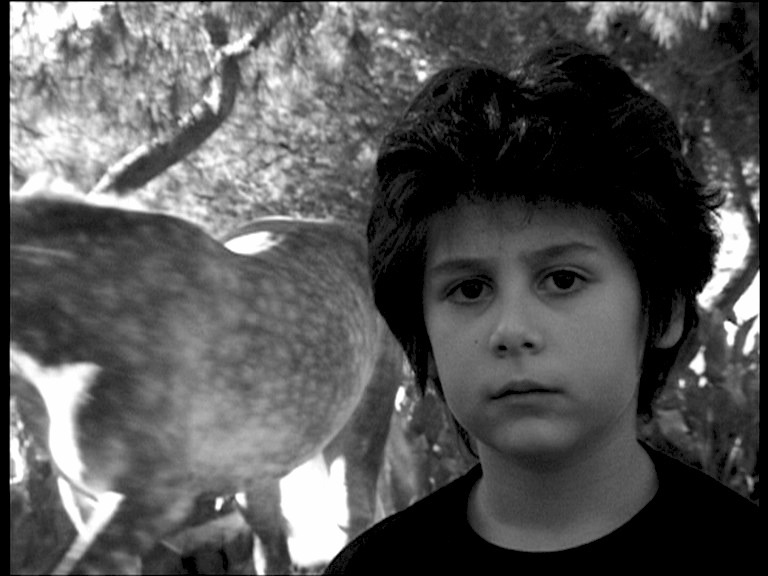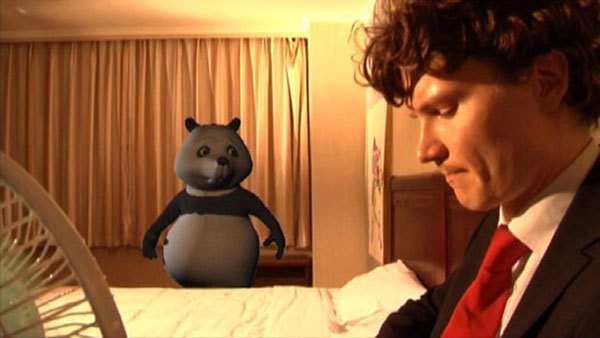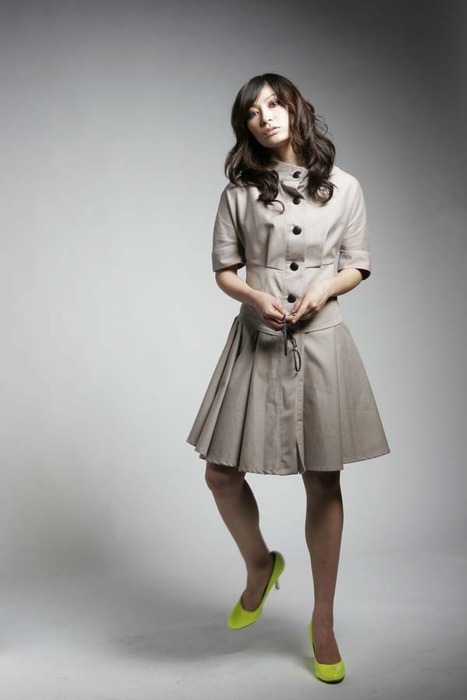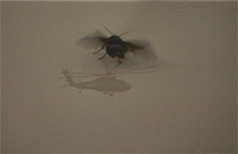
Those were the days
News, notes, screenings and ramblings from Directors Lounge, the mothership of media art.

Those were the days

HAIRS, Milos Tomic, Czech Republic, video to music performed by Ridina Ahmetova
The proliferation of patterned birds on fabric held in pre-ordained proximity to one another seen in erratic motion in his film Clay Pigeon return here in the form of patterned blue roses on porcelain. Tomic’s works have a distinctive stamp to them. In Hairs, accompanied by a layered female voice soundtrack, he cuts and rearranges hair, in tresses and individually, with camera trickery to form shapes reminiscent of the patterns he shows on teacup saucers, with the distinction that the hair has an unsettling quality: alive, but dead. In bundles, we see them as attractive and stylish; individually, they seem nasty and repulsive, like strange creatures coiling themselves up in this arrangement and that out of some sense of instinct. Occasionally, they play with images on the crockery, encircling painted-on heads of innocuous-looking birds, taking on actual intelligence. Lending them heretofore unexpected qualities is like taking Hitchcock’s The Birds to the next level, where other omnipresent but largely ignored “creatures” reveal unsuspected and individual behaviour; this time, it is inanimate “beings” that answer a call to “life”. What works best here is the uncomfortable appeal that pulls in two directions: are the hairs beautiful (as when seen together) or rather off-putting (as when seen separately, playing on surfaces meant for eating)? The influence of fellow Czech Jan Svankmajer is strong; as well, something here shares a quality with Dali’s more erotic paintings. A concisely-executed visual treat.
DROMOSPHÄRE, Thorsten Fleisch, Germany, 10 min 02s, HD, 2010
shown in German Premiere
A visual study of speed. The ephemeral phenomenon becomes palpable as a speed sculpture begins its relativity dance along space-time avenues lined with uncertainty trees.
It could be that the “Bravo!” calls that were heard from the audience as the title shots of the film came up were based on anticipation of seeing something by a filmmaker whose work has included the visually and conceptually astounding Gestalt (2003) or the slightly less riveting but nonetheless interesting Energie! (2007). Dromosphäre, however, doesn’t live up to the promise the maker of these two films invites. At the start, a black screen is marred only by beams of coloured light like an incomplete prismatic breakdown in a small portion to the right of the picture. The lightplay takes shape slowly before our eyes to the sound of an electronic beat, which scales a crescendo as the image claims more and more of the screen. The dominant colours are blood-orange and white, and seem to resemble a car, which the evolving form in fact turns out to be: a model of a white-paneled sports job circa 1960’s. The problem is, once the identification is confirmed, the film seems overlong in its exploration. Unlike the aforementioned films, this one seems to have a goal of sorts, i.e. the slow revelation of a recognizable form, which also gives it a finite quality that has to be observed. Considering the anticipation shown, the applause afterward also seemed less than wildly enthusiastic. Surely Fleisch has more to offer in the future. If this had been a debut or early work, he would have nothing or little to live up to. As it is, one expects progress or at least the maintenance of a certain level of inspiration.

NATURE MORTE, Juha van Ingen, Finland, 2007, 4min 30sec 2007
This short film is a series of beautiful, black and white images mirrored from a central line of division, like a simpler version of a kaleidoscope. Mostly, we see portions of zebra skin, the stripes forming and reforming themselves according to the camera’s position. Later, a full head, doubled as in the earlier shots, appears, as does that of a gazelle. While the film is greatly pleasurable on an aesthetic level, it loses what it might have built upon through the extremely repetitive soundtrack, a few bars of (albeit fittingly dream-inducing) melody that are looped rather than developed. Oddly less than the sum of its parts.

GOOD MORNING AMERICA, Director: Dikran Janus Kadagian US Poet: Carl Sandburg 6min 43s 2007
The sight of American children reciting the Pledge of Allegiance always has the feel of a strange rite of induction into a society that demands obedience from very early on, before one has the chance to sort out for oneself how close to the national flag one wishes to stand. The film opens with late 50’s or early 60’s shots of this ritual in close-up shots of individual children’s faces, all with eyes that seem devoid of any expression, as though brain-washed, and moves to a classroom shot of the same children singing “My Country ‘Tis Of Thee” to the ominous sound of extended bassoon tones and a gentle music-box melody. Rural scenes at dusk follow, and we are reminded that “In God We Trust” in stamped into every U.S. silver dollar over shots of helmeted soldiers preparing their tents in the warm glow of a sunset. From the poem we hear that “we” is “you and me and all of us in the United States of America” while we see diverse scenes of disparate people in varying situations: a baby in a park, newlyweds leaving a church, a “man of the cloth” walking on a congested urban street. The sped-up vintage shots of crowds making their way through traffic are a forerunner of Koyaanisqatsi (as are later scenes of industrialization). “Trusting God means we give ourselves, all of ourselves, the whole United States of America, to God, the Great One,” we hear, followed by, “Yes, perhaps… is that so?”, upon which the title “Good Morning America” appears, and is seen by the viewer not as a greeting, but as a wake-up call. The film moves to scenes of automated mass production, seeming no less alienating or alienated than the children’s faces seen earlier, while the poem continues: “Speed, speed, we are the makers of speed.” Both man and machine hold a strange fascination here, for, whatever the intent, the repetitive nature of both recitation and mass production are hypnotic. Intermittently, we see the products in their finished and ready-to-display form, as if being reminded what all the industrialization is for. The unconscious connection is that the children seen earlier are similarly “processed”, made into shiny, normed products that serve a selected purpose. Speed was also involved in reaching children before it was too late; it came from “us” the reader emphasizes over and over again in a forceful reading of the poem. “Put the blame on us”. The foreboding tones offset by a sweet, aimless melody continue as we see the final shot, sheets of dollar bills being removed from presses for quick inspection. Speed meets value meets values. A good recitation and a well put together short film.

ON DEATH, Director: Anastassios Langis GR Poet: George V. Markis 6min 24s 2007
Here we are witness to (apparently the ghost of) a boy of about ten who recites a 1943 poem by George V. Markris. His delivery is strangely impassioned and dispassionate, something like the style adopted by Juan Perón and others in addressing the masses. The underlying hollow hum is an unsettling element in the proceedings. Standing alternately before a horse, Greek flags waved in a street demonstration, and other incongruous scenes for the pontificating youth’s presence, he tells us more of his “infinite deaths” (including one in Paris, of syphilis), but fails to truly connect. One can’t help feeling the child used is so wholly unaware of the meaning of what he is saying that he might as well be reciting the ingredients in a recipe. Still, the juxtaposition is an interesting idea, but might have been served better with a child more given to flights of fantasy, possibly a younger child with a more intense sense of drama often accompanying “play-acting”.

NIGHT SCHOOL, Erkka Nissinen Finland, 2007, 12min 50sec
What goes on during those long Finnish nights? One film, shown in the “Unnatural Resources” section of films, all from Finland, might provide an answer. Night School certainly earns the title “offbeat”, and then some. This excursion into disconnected imagery had the audience sitting forward in their seats again with their eyes wide open. It begins with cold interior shots reminiscent of Kubrick’s 2001, with a young man standing before a Star Trek-like octagonal portal. We are soon on the soft shoulder of a out-of-town stretch of road and see a scantily clad young woman who appears to be hitchhiking and then dragged lifeless from the scene by a man. The mood has gone from alienating to disturbing, but quickly switches to bewildering when an animated toy-like panda shows up in the same shot. An animated panda? Why? Before the now highly attuned audience can figure this out, a stumbling chef appears in the same night scene, emerging from behind a bush. What to make of it? Then we are back to the cold interior with its machine-like hum in the background, and the initial figure intones “Hello to me, hello to you,” and further words centring around talk of an “institution” strung together in a bizarre half-speech, half-melody accompanied by sign language. Then the chef, (animated) panda and the girl from the highway scene appear side by side in the space behind the aforementioned portal, moving in stiff unison. Where can you go from here? Well, of course to a completely white living room, where the young man from the first scene, devoid of emotion, tells the panda, sitting next to it on a couch, “I think you are really hot” and “I have these feelings for you” and more, to the squeaky-voiced protests of the panda, who nonetheless turns up with the young man in a bedroom, obviously contemplating whether to have intercourse or not. This scene has the feel of another Kubrick work, the uncomfortable bedroom scenes of Eyes Wide Shut. The panda says, “I’m leaving you” and soon the same young man (who is in fact the filmmaker) is shown as the girl (or transvestite) from earlier being urinated on by two chefs, talking all the while. Soon, she is under a table and performing fellatio on one of three chefs, all of whom have been speaking robotically in unison, the word “ping-pong” coming up most often. In the end, the “girl” is standing up and smoking a cigarette, trying to speak with semen dripping out of her mouth in copious amounts. Is there a message here anywhere? “Exercises for assimilation into a total institution,” according to the filmmaker. The question might be, does there need to be? What Erkka Nissinen achieves here is the disjointed logic of dreams, coupled with a highly unusual sense of humour which won’t likely be forgotten too quickly by any viewer. Only a cartoon oddity called Sealab Uh-Oh ever left me with such an odd aftertaste. The surprise submission certainly turned out to be “that film” of the evening, whatever the intention might have been. Worth a watch, certainly. You’ll never see pandas in the same light again.

Tonight´s VJ Special Fri 19th 11:30 pm
“Panic! It sounds like a toy box turned up side down.
How can she make such pretty & chaotic sounds!?
I love it!”
– Ryuichi Sakamoto
Kyoka
What on earth is a kyoka? Simply a solo artist whose cut-up-and-dance laptop electronica suggests more screws loose than fully tightened? Her style has seen her labelled as anything from a pop idol to a noise artist. And as it is usually the way, the truth lies somewhere in between. Starting her solo career at university as a side-project to her school band, Kyoka quickly found herself favouring ever-more unusual outlets for her scatterbrain sound. Finding J-pop utterly unpalatable, she began to look overseas, finding live shows in Europe and the US as well as presenting her own show on Britain’s Resonance FM, ‘Postcards From Kyoka’.

TAKE-OFF, Katherine Liberovskaya, music: Al Margolis (IF, BWANA)
2006, 24 minutes, color, stereo
(Editor’s note: The filmmaker is Canadian, not American, as stated in the program. She is based in Montreal, but has been spending the greater part of her time in New York as of late. The soundtrack, however, is credited to an American. Her film was submitted to DL from New York, hence the confusion.)
Katherine Liberovskaya’s film Take-Off is the kind that may not find favour with all. It is however, in what I believe to be its aim, successful. The film begins with close-up shots of a mosquito, over which we hear the insistent drone of the soundtrack (courtesy of Al Margolis, a.k.a. IF, BWANA). The mosquito gives way to a housefly in similar close-up, its wings fluttering at high speed, waiting to “take off”. This goes on with little change for such an extended period of time that the viewer becomes lulled into lazy voyeurism; similarly, the soundtrack’s drone has a curiously agitating but largely soothing effect, much like that accompanying the hum of a washing machine. So hypnotized into a dreamy state is the viewer that it is with surprise that he notices about eight minutes into the film that the fly is suddenly no longer there: a shadowy image change has replaced it with a helicopter of similar size on the screen. It has already “taken off”, and we are witness to similarities in sound and intent between the two. Now that we are aware that we should be prepared for unexpected changes, we are a little more attuned to nuances of image, and we pick up more readily the interplay of layered pictures. About twelve minutes into the film, we start to see these hazy multiple images of helicopters come together so that it appears we are seeing two mating in mid-air. What we are looking at now is a electronic moving image painting, which eventually leads us back, for symmetry’s sake, to the housefly, which itself takes off. Those who approach a film like this waiting for “plot advancement” will surely be disappointed, but those who are prepared to take the time to be mesmerized will most likely enjoy the experience. The strength of Liberovskaya’s film is in the time she allows for the images and sound to take slow effect. In a world of instant pleasures, a film like this can be a refreshing change.

In dem am Montag von André Werner kuratierten Block Secret Codes, wurde die Videoarbeit Duets (2009) von Gast-Kuratorin Catherine Forster präsentiert.
In diesem sehr abstrakt gehaltenem Video wird die Gegensätzlichkeit von persönlichem Rückzug und aktionistischem Handeln, zwischen Passivität und Aktivität thematisiert. Zu sehen bekommt man in dem Video Nahaufnahmen einer Wasseroberfläche, die mit einer Großzahl an unterschiedlich großen oder kleinen Luftblasen versetzt ist. Durch Wellenbewegungen geraten die Luftblasen in ein dynamisches Durcheinander, von dem eine beruhigende Wirkung ausgeht. Die Distanz der Kamera zur Wasseroberfläche variiert von Zeit zu Zeit und lässt dem Betrachter dabei Gelegenheit sich mit dem zuvor gesehenem Bild eines Fischschwanzes, gefilmt durch die Außenwand eines Aquariums, zu beschäftigen. Die thematische Auseinandersetzung mit dem Motiv des Wassers entstammt aus der von Catherine Forster beschriebenen Allegorie des Wassers als Rückzugsmedium. Verständlich wird das, wenn man bedenkt, was passiert, wenn man mit dem Körper unter Wasser taucht. Die Geräusche der Umwelt verblassen, die Gesetze der Schwerkraft werden ausgeschaltet. Es scheinen für den Moment keine Bindungen, keine Verpflichtungen zu existieren. Gleichzeitig jedoch kann das Wasser auch als Gefängnis verstanden werden, als Bedrohung. Innerhalb dieses Zwiespalts versucht Forster ihrer Beklemmnis gegenüber dem Entscheiden Ausdruck zu verleihen. Rückzug oder Wagnis? Sicherheit oder Freiheit?
Diese Unentscheidbarkeit oder Mehrdeutigkeit spiegelt sich in der Wahl des ausgesuchten Materials wider. Jedoch wird dem Versuch, Ausgeglichenheit innerhalb dieser Ambivalenz zu suchen, Rechnung getragen, wenn man die Gelassenheit des Videos bedenkt.
Von Martin Tscholl